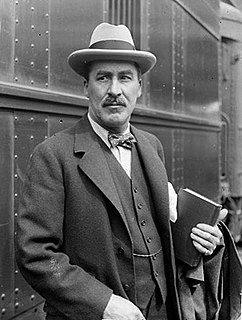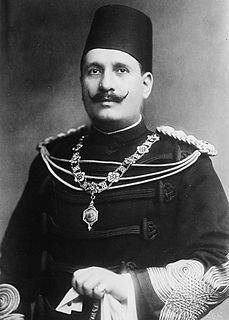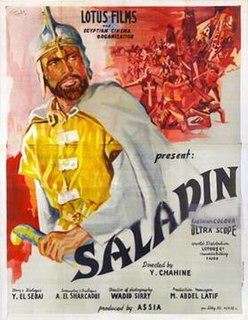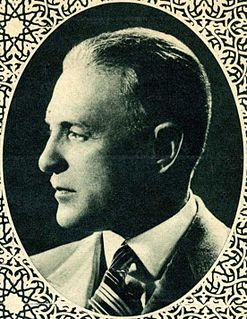
Howard Carter was an English archaeologist and Egyptologist. He became world-famous after discovering the intact tomb of the 18th Dynasty Pharaoh, Tutankhamun in November 1922, the best-preserved pharaonic tomb ever found in the Valley of the Kings.

Tutankhamun, Egyptological pronunciation Tutankhamen, commonly referred to as King Tut, was an ancient Egyptian pharaoh who was the last of his royal family to rule during the end of the 18th Dynasty during the New Kingdom of Egyptian history. His father was the mummy found in the tomb KV55, believed to be the pharaoh Akhenaten. His mother is his father's sister, identified through DNA testing as an unknown mummy referred to as "The Younger Lady" who was found in KV35.

Muhammad Anwar el-Sadat was an Egyptian politician who served as the third President of Egypt, from 15 October 1970 until his assassination by fundamentalist army officers on 6 October 1981. Sadat was a senior member of the Free Officers who overthrew King Farouk in the Egyptian Revolution of 1952, and a close confidant of President Gamal Abdel Nasser, under whom he served as Vice President twice and whom he succeeded as president in 1970. In 1978, Sadat and Menachem Begin, Prime Minister of Israel, signed a peace treaty in cooperation with United States President Jimmy Carter, for which they were recognized with the Nobel Peace Prize.

Muhammad Hosni El Sayed Mubarak was an Egyptian military and political leader who served as the fourth president of Egypt from 1981 to 2011.

Akhenaten, also spelled Echnaton, Akhenaton, Ikhnaton, and Khuenaten, was an ancient Egyptian pharaoh reigning c. 1353–1336 or 1351–1334 BC, the tenth ruler of the Eighteenth Dynasty. Before the fifth year of his reign, he was known as Amenhotep IV.

Fuad II is a member of the Egyptian Muhammad Ali dynasty. He formally reigned as the last King of Egypt and the Sudan from July 1952 to June 1953, when he was deposed.

Fuad I was the sultan and later king of Egypt and Sudan, sovereign of Nubia, Kordofan, and Darfur. The ninth ruler of Egypt and Sudan from the Muhammad Ali dynasty, he became sultan in 1917, succeeding his elder brother Hussein Kamel. He substituted the title of king for sultan when the United Kingdom recognised Egyptian independence in 1922.

Sahure was a pharaoh of ancient Egypt and the second ruler of the Fifth Dynasty. He reigned for about 12 years in the early 25th century BC during the Old Kingdom Period. Sahure's reign marks the political and cultural high point of the Fifth Dynasty. He was probably the son of his predecessor Userkaf with Queen Neferhetepes II, and was in turn succeeded by his son Neferirkare Kakai.

Saif ad-Din Qutuz, also romanized as Kutuz, Kotuz, and fully al-Malik al-Muẓaffar Sayf ad-Dīn Quṭuz, was a military leader and the third or fourth of the Mamluk Sultans of Egypt in the Turkic line. He reigned as Sultan for less than a year, from 1259 until his assassination in 1260.

Nazli Sabri was the first queen consort in the Kingdom of Egypt from 1919 to 1936. She reigned as the second wife of Fuad, King of Egypt.

Abdelfattah Amr, better known as "F.D. Amr Bey" or simply "Amr Bey", was an Egyptian diplomat and squash player. He won the British Open men's title six consecutive times (1933–38), and is considered the first truly dominant squash player in the sport.

Saladin the Victorious, also known as Saladin and the Great Crusades, is a 1963 Egyptian war drama film directed by Youssef Chahine. It was written by Youssef El Sebai, based on the novel by Naguib Mahfouz. It stars Ahmed Mazhar as Saladin, Salah Zulfikar, Mohamed Abdel Gawad, Tewfik El Dekn, Omar El-Hariri, Mahmoud El-Meliguy, Leila Fawzi, Hamdi Gheiss, Ahmed Luxor, Nadia Lutfi, Hussein Riad, Laila Taher and Zaki Toleimat.

Downtown Cairo, has been the urban center of Cairo, Egypt, since the late 19th century, when the district was designed and built.

Rawya Ateya was an Egyptian woman who became the first female parliamentarian in the Arab world in 1957.

Youssef Zulficar Pasha was an Egyptian judge. He was the father of Queen Farida of Egypt and thus father-in-law of King Farouk I.

Melek Hassan Tourhan was the second wife of Sultan Hussein Kamel of Egypt. After her husband ascended the throne in 1914, she became known as Sultana Melek.

Parliamentary elections were held in two stages in Egypt in 1923 and 1924, the first since nominal independence from the United Kingdom in 1922. The result was a victory for the Wafd Party, which won 188 of the 215 seats.

The Cairo fire, also known as Black Saturday, was a series of riots that took place on 26 January 1952, marked by the burning and looting of some 750 buildings—retail shops, cafes, cinemas, hotels, restaurants, theatres, nightclubs, and the city's Opera House—in downtown Cairo. The direct trigger of the riots was the killing by British occupation troops of 50 Egyptian auxiliary policemen in the city of Ismaïlia in a massacre one day earlier. The spontaneous anti-British protests that followed these deaths were quickly seized upon by organized elements in the crowd, who burned and ransacked large sectors of Cairo amidst the unexplained absence of security forces. The fire is thought by some to have signalled the end of the Kingdom of Egypt. The perpetrators of the Cairo Fire remain unknown to this day, and the truth about this important event in modern Egyptian history has yet to be established.
Şehzade Mahmud Namık was an Ottoman prince, the only son of Şehzade Ömer Hilmi, and his second wife Gülnev Hanım. He was the grandson of Sultan Mehmed V Reşad and Mihrengiz Kadın.


















